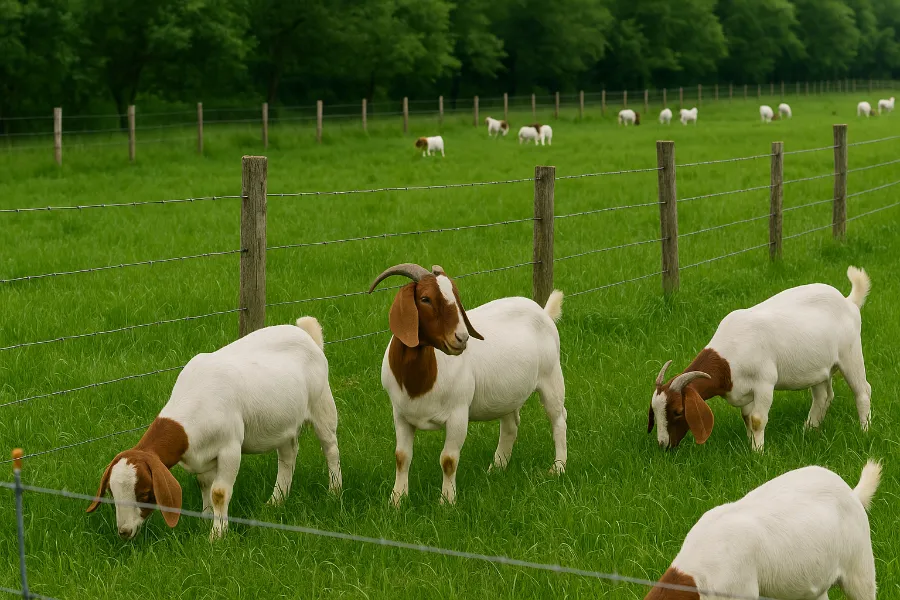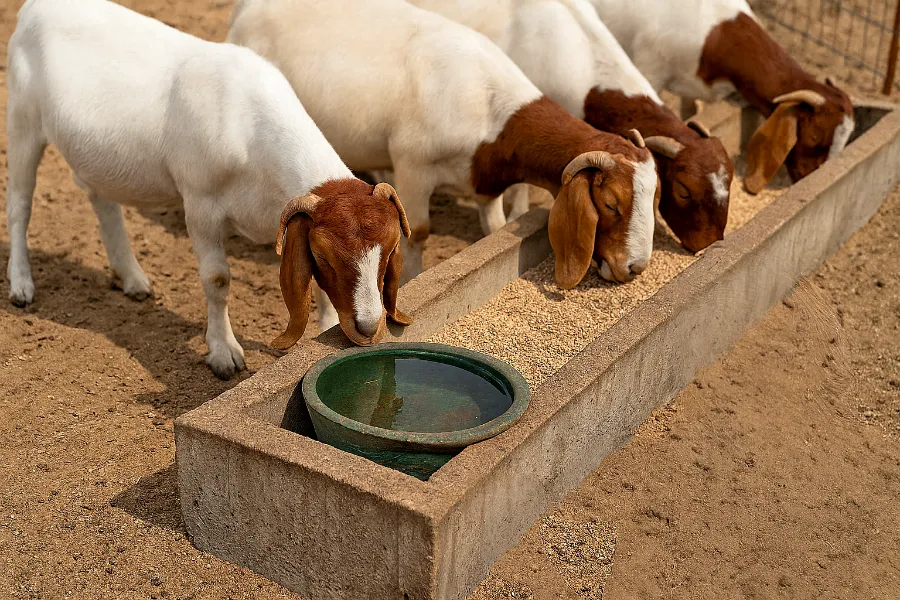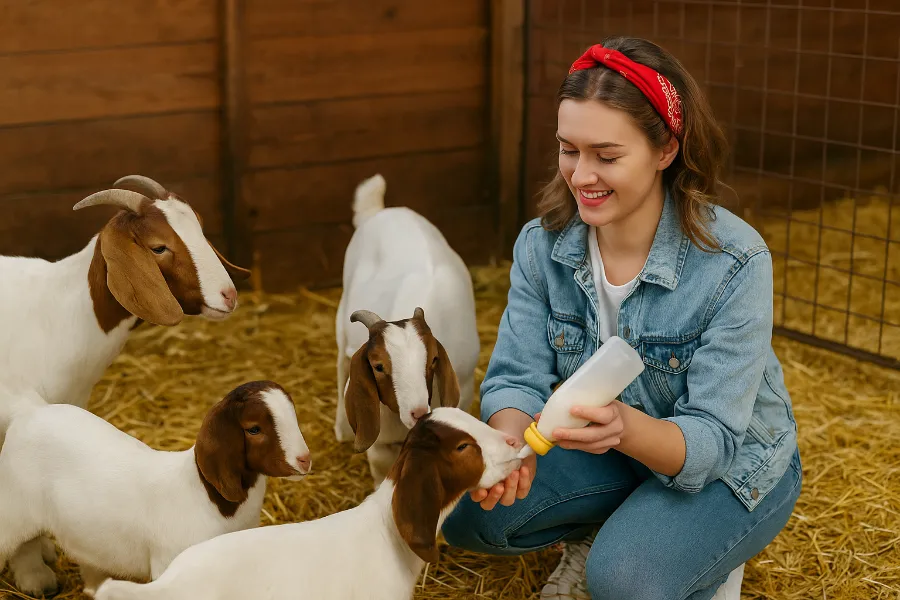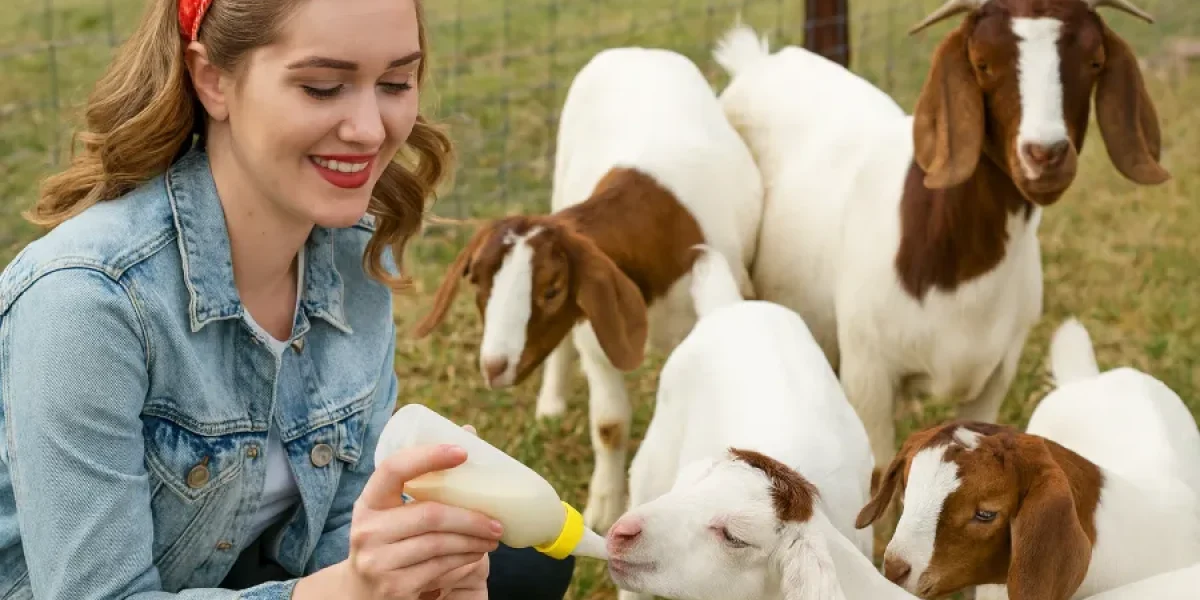I’ll be honest—when I first got interested in meat goats, I shopped around several breeds, read a dozen forums, and visited neighbors who kept goats. But every conversation circled back to one name: Boer goats. They’ve earned their reputation for good reason.
They grow fast, carry muscle well, adapt to heat, and tend to give strong birth numbers (twins or triplets are common). In my herd, I found that Boer kids hit market weight quicker than I expected. As meat goats, they really deliver. For someone like me, who’s balancing time, land, and budget, that performance makes a huge difference.
When you frame your operation around meat goats, choosing a breed that can deliver consistently is half the battle. Boer goats gave me that confidence from day one.

Meat Goat Farming: Setting Up for Success
If you’re going into meat goat farming with Boer goats, there are a few foundational choices you can’t skip. These early decisions will ripple throughout your entire operation.
Start with a clear goal
Ask yourself:
- Do I want this as a small homestead project or a serious income source?
- How many does and bucks can my land support?
- What’s my timeline for my first market-ready kids?
When I started, I aimed for a small but manageable herd—just ten does—and decided to expand once my systems ran smoothly. That let me make mistakes without risking disaster.
Understand your land and forage
Goats aren’t cows. They browse—they prefer shrubs, weeds, leaves, and brush to uniform pasture grass. I mapped my property, identified patches of brush and edge habitat, and planned rotational areas. That way, I could rest areas to recover and cut down on parasites.
A rough rule I use: 1 acre per 6–8 goats, depending on forage quality. But that’s flexible—if your browsing mix is rich, you can push it.
Organize infrastructure early
You’ll want:
- A solid shelter (dry, ventilated, draft-free).
- Pens for separating bucks, does, and kidding mothers.
- Space for kids to nurse and move without stress.
- Feeding and watering stations positioned to avoid mud or contamination.
When I first ignored drainage, mud became my enemy. Now I grade the pens and keep “sacrificial areas” (where the goats walk most) well drained.
Goat Farming: Daily Habits That Matter
I often say that goat farming is more about habit than heroics. The systems you build—daily, weekly, seasonally—determine your results more than any single miracle cure.
Morning and evening routines
I check waterers first (goats drink more than you might expect), then inspect feed troughs and mineral stations. A quick walk through the herd tells me who’s limping, off feed, bloated, or out of sorts. I note those and follow up.
Cleaning pens, scooping droppings, and refreshing bedding helps stave off parasites. I do this for 20 minutes twice a day. It pays off in fewer deworming needs and healthier goats.
Record keeping
I keep a small notebook (and a phone backup) with each goat’s birth date, weights, breeding dates, health treatments, and any oddities. Later, when it’s time to cull or sell, that data tells me who was a rock star and who held me back.
Rotational grazing and parasite control
After learning too many hard lessons, I switched to rotational grazing. Move goats every few days. Allow paddocks to rest 3–4 weeks so larvae don’t build a heavy load. I also pull fecal samples and work with a vet to rotate dewormers intelligently. Overuse of one drug leads to resistance, and I refuse to get trapped by that.
Goat Fencing: What’s Worked for Me
Goats are famous escape artists. In fact, I once lost a buck overnight because of a weak gate. That taught me: goat fencing is one of the non-negotiables in this business.
What I use
- Woven wire, 4 to 5 feet high: strong barrier, hard to climb.
- Electric wire (hot wire) strung along the top and sometimes the bottom: keeps them in and predators out.
- Reinforced gates with heavy latches (goats test them).
I also bury a short “skirt wire” (a few inches into the ground) in vulnerable areas to prevent digging. Every season, I walk the fence line and repair weak spots or bends. A little maintenance saves heartbreak.
Predator deterrence
Coyotes, stray dogs, even raccoons can cause chaos. In my herd, I’ve used:
- A guardian dog (Great Pyrenees)
- A donkey companion
- Motion-activated lights at night
Together, they add an extra layer of security that often keeps me from losing goat nights to predators.
Raising Boer Goats for Meat: From Birth to Market
This is the core: how to get kids into your pens and then to market weight on schedule.
Breeding strategy
- Breed does at 7–10 months (if they reach ~80 lbs and look healthy).
- Use 1 buck per 20–30 does—overuse exhausts the buck and increases injury risk.
- Track breeding dates carefully so you can anticipate kidding windows.
Gestation is ~150 days. I aim for a fall kidding season so spring forage is ready when kids hit 2–3 months.
Birthing and early life
I watch does in the last two weeks for signs of labor. I keep lambing/kidding pens clean, warm, and quiet. I often assist first-time does and always check that kids nurse within the first few hours. A tub of colostrum warms me inside when I see twins standing and nursing within moments.
Kids stay with their mothers until ~90 days (weaning). During those weeks, I introduce creep feed starting at 10–14 days old—a small feeder only they can access. This jump-starts growth and transitions them.
Growth and market targets
In my herd, kids regularly hit 80–100 lbs by 5–7 months. Some heavier. Some slower. I track individual weights and cull underperformers early (usually before 4 months) to save feed costs.
It’s not perfect, but over the years I’ve trimmed my “underperformer” list to just a few each season.
Boer Goat Feed: What They Really Eat
Feeding is often where people overthink. I kept it simple, learned by doing, and tweaked for results. Critical term: Boer goat feed.
Forage and browse first
My goats browse first—they prefer leaves, brush, weeds. I let them browse heavily and supplement with feed, rather than feed heavy and hope pasture helps.
Rotating browsing areas keeps feed supply steady, and brush-heavy areas help reduce parasite risk (larvae don’t like dry, exposed browse).
Supplemental grain and concentrates
Depending on age, weight, and goals:
- Kids/fast growers: Corn, oats, alfalfa, soybean meal mixed into goat-specific pellets.
- Does (non-pregnant): Lower-energy pellets, some grain, and lots of forage.
- Pregnant/nursing does: Higher protein rations with good mineral balance.
Around 2.5–3% of body weight in total feed (for fast-growing kids) has been my ballpark benchmark, adjusting with weather, forage availability, and health.

Minerals and water
Loose, free-choice minerals tailored to goats are mandatory. Copper needs are critical—goats require some, but too much is dangerous. I avoid sheep blends because they lack copper.
Water: fresh, clean, always. In heat, I often refill twice a day. Goats will slow down growth if water is scarce or stale.
Challenges, Lessons, and What I Would Do Differently
I won’t sugarcoat it—meat goat farming with Boer goats tested me. But these challenges also taught me what to prioritize.
Parasite resistance
This is my ongoing battle. If you rely solely on dewormers, you’ll lose. The combo of good manure management, rotational grazing, fecal testing, and targeted deworming has been my key.
Feeding cost swings
Grain prices fluctuate. Some seasons I’ve paid double what I expected. I buffer by storing feed early and growing more browse.
Infrastructure wear
Fences age. Gates sag. Posts rot. I learned to budget 5–10% of gross revenue for maintenance. It’s non-glamorous but essential.
Heat and cold stress
In early years, I lost kids in freak cold snaps or hot spells. Now I watch weather forecasts like they’re stock reports and provide supplemental heat or shade as needed.
If I were to start over, I’d invest more in early water infrastructure and better drainage. That alone would’ve saved me a lot of headache early on.
Final Thoughts (From My Goaty Heart)

I still stroll my pastures at dawn, listening to bleats, spotting kids leaping among brush, and tweaking paddocks. Raising Boer goats for meat has become more than a farm project—it’s a calling.
If you’re reading this and thinking, “Yes, I can do this,” then you can. Use smart meat goat farming strategies, invest in goat fencing up front, feed well with balanced Boer goat feed, and don’t skip daily care. Mistakes will happen—they did for me—but every season I’ve learned, improved, and grown.
Your goals with raising Boer goats for meat are totally within reach. And when you hold that first kid, soak in the moment. Because it’s the start of something amazing.
FAQs
Yes, Boer goats are one of the best meat goat breeds thanks to their fast growth and muscular build. They consistently produce high-quality carcasses with excellent meat-to-bone ratios.
On average, 1 acre can support 6–8 Boer goats depending on forage quality. Rotational grazing helps maximize land use and reduce parasite issues.
A mix of browse, forage, and supplemental grains like corn, oats, and soybean meal works best. Always provide loose minerals and fresh water daily.
Strong woven wire fencing at least 4–5 feet tall is ideal. Adding an electric strand can help keep both goats in and predators out.
Kids are usually weaned around 3 months and can reach market weight at 5–7 months. With proper feeding and care, they grow quickly into profitable meat goats.
Boer does can breed twice every 18–24 months and often produce twins or triplets. Their strong maternal instincts make them excellent for herd growth.
Yes, Boer goats are highly profitable due to their fast growth and consistent demand for goat meat. Profitability depends on feed costs, fencing, and health management.













